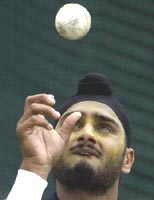On March 3, 2005, the International Cricket Council cleared off-spinner Harbhajan Singh's action, and gave him the go ahead to play the series against Pakistan.
18 days later, on March 21, the ICC match officials reported the very same bowler for a suspected illegal bowling action, at the end of the second Test match between India and Pakistan.
 "The report relates specifically to the bowler's action when delivering the `doosra'," said match referee Chris Broad.
"The report relates specifically to the bowler's action when delivering the `doosra'," said match referee Chris Broad.
"It was noticeable to the umpires and me that there was an apparent change in action when bowling this delivery between the first innings of the match, when no concerns were raised, and the second, which then prompted the report to be made."
The report is, to say the least, worrisome. Ridiculous, would be an equally valid adjective.
Look at it this way: An ICC match referee reports Bajji. The ICC appoints specialists to examine the action, with special reference to the 'doosra'. The specialists give the delivery a clean chit. And the first time Bajji bowls, the ICC match referee reports the delivery again.
The action raises a question: Did the ICC not pass on to the match referee the report of the biomechanical study of Bajji's action?
If the ICC did pass it on, and if the match referee for this series did receive it, then we have an even more interesting situation here -- an ICC official is, by reporting Bajji now, questioning the validity of the assessment -- under the ICC's imprimatur -- by Australian bio-mechanics expert Bruce Elliot, whose biomechanics team at the University of Western Australia has also allowed Muttiah Muralitharan to continue using his doosra until the completion of further biomechanical research into slow bowling.
So how does this go, now? The same biomechanical expert will examine Bajji, come to the same conclusions, let him bowl, and the match referee will report him again?
And so on, until sheer frustration forces the bowler out of interenational cricket?
An equally significant question relates not to the role of the match referee, but to his identity.
Christ Broad was the match referee in Bangladesh, for the December 2004 series featuring India. Harbhajan was first reported after India's second Test against Bangladesh in Chittagong in December.
An upset Harbhajan had, on that occasion, given vent to his frustration. "First tell me how Match Referee Chris Broad was so sure that I was violating the 15-degree barrier? Can it be measured by the naked eye?" Harbhajan had then asked.
"I did meet him (Broad). And he repeatedly said one thing: 'I think ... I think.' So I asked him, "Why do you keep saying that you think?
"If you are sure that I am violating the rule, then say it. Otherwise don't make any comments."
So guess who the match referee is for the ongoing series between India and Pakistan? Christ Broad, no less.
And the first time Bajji bowls after that previous report, Broad reports him again. This is also the first time since the ICC's new regulations concerning suspect actions came into place on March 1.
The match officials have specifically said that the `doosra' is the ball in question -- a ball, it bears repeating, that was cleared by the ICC-appointed biomechanics expert.
It was apparent, the officials admitted, that Bajji used the doosra very sparingly in the Kolkatta Test, and relied mostly on the orthodox off-spinning delivery and the one that goes straight with the arm.
When I met Bajji in Mumbai -- the offie had come to take part in a Tsunami benefit game -- and asked him about the chucking controversy, he seemed quite unruffled.
He said first time he was called, in 1998, he was very nervous. But now, with the ICC reporting bowlers frequently, he had gotten used to it and it didn't seem to make much of a difference, he said.
But though the spinner was seemingly sanguine, those who watched him bowl at the Eden Gardens will agree he was not at his best, that he seemed to be bowling within himself, eschewing most of his variations.
Obviously, the fact of having been reported in Bangladesh, and having to then go under the ICC microscope, was preying on his mind. Word is also that the team management advised him to take it easy, to ease himself back into the groove, even if it meant he bowled a bit under par at the Gardens.
So now what impact will this latest report have on the spinner? How will it impact on his performance at Bangalore -- where Broad, as match referee, will continue to have him under scrutiny?
The larger question is whether this procedure is fair to a player. Sure, if his action is suspect, he needs to be reported, his action needs to be studied, correctives need to be applied if necessary, and he needs to be cleared before he plays again.
But can this happen from one match to another? You play a Test, you are reported, you go to the trouble and expense to clear your name, and the very next Test that you play in, you are reported again?
If that is the case, then what validity, what value, does the biomechanics study have anyway? Why does the ICC insist on subjecting bowlers to the time and effort, if its own officials are not prepared to accept the verdict?






